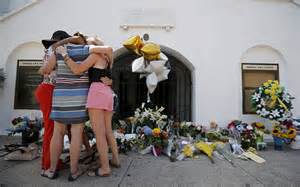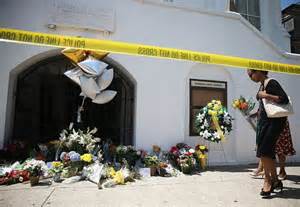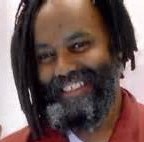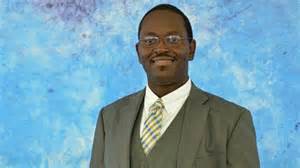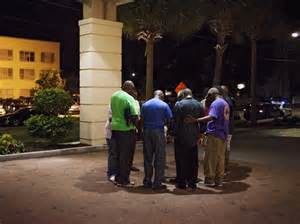 By now, the news media have run out of excuses to insist that the massacre at Emanuel African Methodist Episcopal Church was anything other than a hate crime. Politicians from South Carolina Governor Nikki Haley to several US Congress Members have called for the Confederate Flag that still waves in front of the South Carolina State House, considered a key inspiration for the murderous rampage of Dylann Storm Roof, to be taken down. Church leaders and prominent members of the Afrikan American community have spoken words of sympathy and healing for the families of the victims and for the communities of South Carolina and, frankly, across the South, as they struggle to come to grips with a yawning racial divide that they have ignored for far too long.
By now, the news media have run out of excuses to insist that the massacre at Emanuel African Methodist Episcopal Church was anything other than a hate crime. Politicians from South Carolina Governor Nikki Haley to several US Congress Members have called for the Confederate Flag that still waves in front of the South Carolina State House, considered a key inspiration for the murderous rampage of Dylann Storm Roof, to be taken down. Church leaders and prominent members of the Afrikan American community have spoken words of sympathy and healing for the families of the victims and for the communities of South Carolina and, frankly, across the South, as they struggle to come to grips with a yawning racial divide that they have ignored for far too long.
A number of Human Rights Organizations across the United States have made statements concerning the massacre of nine Afrikan people as they prayed in a Charleston, South Carolina church on Wednesday, June 17. A few of these statements were sent to us, and we share them with you below.
A related post includes statements from several Pan-Afrikan organizations, and we will offer some of our thoughts in a separate post as well.
Heather Gray of the Justice Initiative wrote the following article for Counterpunch Magazine:
The Violent Roots of Southern Racism
The Massacre in Charleston: “What Then Must We Do?”
By Heather Gray
Counterpunch
On Wednesday, June 17th, 2015 three black men and six black women were killed by a white youth in Charleston, South Carolina’s renowned Emanuel AME Church. Below are their names:
Cynthia Hurd, 54 years old
Suzy Jackson, 87 years old
Ethel Lee Lance, 70 years old
Rev. De’Payne Middleton-Doctor, 49 years old
Rev. Clementa Pinckney, 41 years old
Tywanza Sanders, 26 years old
Rev. Daniel L. Simmons, 74 years old
Rev. Sharonda Coleman-Singleton, 45 years old
Myra Thompson, 59 years old
Regarding the loss of these remarkable community leaders at the Emanuel AME Church, I am reminded of the “Sweet Honey in the Rock” song named appropriately “Biko”. This was after the brutal 1977 killing of South Africa’s Steve Biko by the South African apartheid regime. Biko was the one of the major founders of the “Black Consciousness Movement” in South Africa. He was famous for his saying “black is beautiful!” Indeed. Sweet Honey sang “You can break one human body, I see ten thousand Bikos”.
Seeing ten thousand “Bikos”? Yes, I would say that we are already witnessing thousands of people expressing outrage at this painful killing in Charleston. So the fact is that there might be a killing of our leaders, but thousands or millions of people will honor them and continue their work for justice in whatever way they can.
This heartbreaking massacre did not occur in isolation. It has been identified as a hate crime. I frankly think it should be identified as domestic terrorism. And, unfortunately, this incident in Charleston was not unique. It is part of a long and painful white supremacist culture in America. The roots run deep. It keeps raising its ugly head.
But then, we can look for our enemy and often realize it is us. Those of us born and bred in the United States. In fact, when President George W. Bush said he was going after terrorists following 9/11 I thought “Good, that means he’ll need to go after the Klan and many right wing Christian groups in America.” It was, of course, wishful thinking on my part.
Here’s what Raw Story/Alternet had to say in its June 18, 2015 article by Alex Henderson:
When white males of the far right carry out violent attacks, neocons and Republicans typically describe them as lone-wolf extremists rather than people who are part of terrorist networks or well-organized terrorist movements. Yet many of the terrorist attacks in the United States have been carried out by people who had long histories of networking with other terrorists. In fact, most of the terrorist activity occurring in the United States in recent years has not come from Muslims, but from a combination of radical Christianists, white supremacists and far-right militia groups (Henderson)
The problem, therefore, rests with those of us who are white and of European ancestry. We are the ones who created this culture and maintain it today. Most of us refuse to admit or acknowledge our racist past and the immorality of it much less to understand and teach its history of exploitation so that we can move beyond it. We keep our heads in the sand most of the time and it clouds our minds and distorts our vision. Generally, we also let other whites get away with too much when we should be stopping them in their tracks. Then many of us teach our youth that because they are white they are somehow special compared to others in the world. It’s a false and distorted pride and resides in a vacuous empty shell of lies.
I would venture to say that many whites, particularly in the South, are still of the opinion that there are different species of our modern humans. This is called racial essentialism, as in, there is different biological intellectual capacity or other characteristics such as industry and character between people of color and so-called whites.
As Professor William Richman in 2006 has stated regarding his article on genetics: “This article answers that basic question (of racial essentialism) by resorting to the rapidly expanding field of molecular population genetics…There simply are no genetically-based pan-“racial” differences in character, intelligence, or any other set of traits crucial to individual or societal success or position; racial essentialism is intellectually bankrupt (Richman).
I invite you to read Richman’s excellent and detailed article about recent genetics studies regarding the dispersal of humans from Africa – Genetic Residues Of Ancient Migrations: An End To Biological Essentialism And The Reification Of Race.
Our different colors are another issue often used to differentiate humans, yet we are all “homo sapiens” with different colors. The colors have to do with our closeness or not to the equator (please go to the footnote below for more detail on skin color.) Race differentiation? There is no such thing. It’s a myth. We are all of the same species with a variety of different colors (Robert Wald Sussman).
The thing is, even if there were differences why would there be this oppression in the first place? Why this long lasting inhumane exploitive behavior by Americans? All this rationale has been in place for centuries to justify slavery, then Jim Crow and now the current legacy of it all. The fact remains that, as was stated, these justifications are fallacies and cultural constructs by the western propagandists and the elite in the U.S. as a way to control the masses for their own intent, and that intent being greed.
All of the above have been tools used by the Southern elite, in particular, from the slavery era. They used the age-old divide and rule strategy of working class whites against the black community in order to achieve their goals. Greed is compelling!
And, unfortunately, the Southern elite, ever since slavery, has instilled this deadly model that we have yet to bury in the dustbin of human history. I venture to say that more than likely the young Dylann Roof, who killed the nine AME pastors and members, was brought up in this distorted and white supremacist culture and/or he managed to find it easily through the media and internet.
It is also important to note also that the white working class in the South is the most marginalized in the region. They are not liked by the middle and upper class whites and have been trained keep their distance from blacks creating a conflict there as well. They are generally exceptionally poor and not engaged politically or civically except in the church, which is often exceptionally fundamentalist in the South. Please be mindful also that the late philosopher Leo Strauss, the godfather of the many on the right, said the people need to be controlled and religion, any religion, he said, is the best way to do this. Many organizers on the right have followed Strauss’ insidious “control” directive, although there has been a long history of using religion as a control tool in the South.
Furthermore, the South has never had the diverse economic system with labor rights that has, in the past, been the model in many parts of the country. But the South never really had a chance with this model compared to other areas. The southern elite simply never let businesses into the region if the business had labor union availability. (Read James Cobb’s “The Selling of the South” regarding actions of the southern elite and businesses coming into the South.) And now U.S. businesses have moved to other countries for cheaper labor and offering no benefits at all, if they can get away with it. Given this, the rural South is all the more desolate as opportunities are all the more bleak. This, of course, is all a part of the neoliberal business plan, being to seek cheap labor, again for greed.
In the rural South, this lack of a diverse economy, including lack of opportunities in the predominant agricultural system that is becoming more industrialized, along with concentrated elite wealth, has led to increased conflict, unsolved murders and drugs.
Finally, the South is, of course, unique in so many capacities regarding white supremacy largely thanks to our slave past and on-going oppressive culture. South Carolina particularly stands out because of its unique slave history and, of course, African resistance to it. Here are some facts from the excellent International African American Museum:
Slavery in South Carolina was different from anywhere else in America:
- Over 40% of all enslaved Africans to the U.S. came in through Charleston
- Population ratios could be as high as 9 enslaved persons to 1 white resident in the Lowcountry
- Enslaved persons comprised nearly 50% of Charleston’s population before the Civil War
Today, nearly 80% of African Americans could potentially trace an ancestor who was brought through Charleston.
South Carolina was the only state founded exclusively as a slave colony.
Founded exclusively as a slave colony, South Carolina quickly grew to have the highest ratio of enslaved persons to free whites of any mainland colony, or later, state.
In the years preceding the Civil War, enslaved people comprised about half of Charleston‘s inhabitants. Population ratios in the Lowcountry were even more extreme, where some areas had 9 slaves to every 1 white resident.
In order to maintain control over the enslaved population, slave laws and methods of punishment were harsher in South Carolina than elsewhere in the country.
It’s important also to know that the primary slave work in South Carolina was in rice production. South Carolina slave owners opted for highly skilled rice growers from West Africa where rice had been grown for at least 3,000 years.
The South Carolina planters were, at first, completely ignorant of rice cultivation, and their early experiments with this specialized type of tropical agriculture were mostly failures. They soon recognized the advantage of importing slaves from the traditional rice-growing region of West Africa, and they generally showed far greater interest in the geographical origins of African slaves than did planters in other North American colonies (Yale).
Furthermore, South Carolina was home – and understandably so – to the largest slave rebellion in U.S. history. Namely, the Stono Rebellion in 1739. This was almost a century before Denmark Vessey (who was associated with the Emanuel AME Church in Charleston) planned a slave rebellion on June17, 1822. Please note that the killings at the AME Church in Charleston took place on June 17, 2015 – a coincidence? Probably not.
And as Leo Tolstoy stated “What Then Must We Do?”
We need, I think, a new paradigm to recover from this sickness that serves only to destroy the other and ourselves as well. The responsibility of making this change rests with whites in partnership with the black community. The response from blacks and white groups joining with black groups the past year, however, around the killings of blacks by white police officers, is impressive; there are groups around the country beginning to address seriously the issue of white supremacy. The Quakers are, as always, noteworthy for their excellent work on this, as has been the case here in Atlanta. The “Black Lives Matter!” movement is taking on a life of its own throughout the country. I am sure these efforts will continue and/or we need to make sure that’s the case!
But most of us need to be more comprehensive in our efforts regarding education about the beginnings of and extent of white supremacist thoughts and action in our culture and ways to counter this, which includes finally learning about Africa and its profound history.
Two rather symbolic, yet important efforts, are, for one, to take the confederate flag from the statehouse grounds in South Carolina as is now being demanded by many South Carolinians. As a friend of mine said, “Having the confederate flag there is a disgrace”. I agree. The other symbolic gesture is that the U.S. Congress has yet to apologize for slavery and Jim Crow.
…just months after President Barack Obama took office, the Senate unanimously passed a resolution apologizing for slavery. The Senate acknowledged “the fundamental injustice, cruelty, brutality and inhumanity of slavery” and apologized “to African Americans, on behalf of the people of the United States, for the wrongs committed against them and their ancestors who suffered under slavery.”
The House of Representatives had passed a similar measure the previous year. But Congress could not resolve the two apologies because of differing views on how the resolution would be used in any discussion of reparations. The Senate version was insistent that an apology would not endorse any future claims. The House could not agree. Significantly, the office of the president of the United States has never issued an apology.
In other words, the United States has never given an unconditional apology for slavery. For a nation that can’t even agree on an apology, the recent conversation around reparations could be seen as little more than an exercise in oratory ().
These directives are but a start to rid ourselves of this white supremacist sickness in America. There are many other recommendations as well, of course. The time is now!
Heather Gray is a writer and radio producer in Atlanta, Georgia and has also lived in Canada, Australia, Singapore, briefly in the Philippines and has traveled in southern Africa. She served as the director of the Non-Violent Program for Coretta Scott King in the mid-1980’s in Atlanta; and for 24 years worked with the Federation of Southern Cooperatives/Land Assistance Fund focusing on Black farmer issues and cooperative economic development. She holds degrees in anthropology and sociology. She can be reached at hmcgray@earthlink.net.
________
Footnote: As humans left Africa and then further away from the equator our skin color changed and became more varied over time. Our black or white skin or variations of color have largely to do with our adaptation to heat – the closer we are to the equator the darker our skin as the “melanin is an effective absorber of light; the (darker) pigment is able to dissipate over 99.9% of absorbed UV (ultraviolet) radiation” (Wikipedia) and in this way we can better survive in an exceptionally warm climate; consequently the further away from the equator, the lighter our skin because we need to absorb more heat and vitamin D (Smithsonian) in order to survive (see the world map of skin color below). There is also a third factor that effects our skin color and it has to do with diet combined with UV rays:
….coastal peoples who eat diets rich in seafood enjoy this alternate source of vitamin D. That means that some Arctic peoples, such as native peoples of Alaska and Canada, can afford to remain dark-skinned even in low UV areas. In the summer they get high levels of UV rays reflected from the surface of snow and ice, and their dark skin protects them from this reflected light ().
Our different skin colors mean an environmental adaptation, with the exception of diet plus environment for Arctic peoples. That’s it!
Statement from the Southern Poverty Law Center
Among several statements on their website, Morris Dees and Richard Cohen wrote the following commentary to the Opinion Page of the New York Times for the Southern Policy Law Center:
White Supremacists Without Borders
By MORRIS DEES and J. RICHARD COHEN Southern Poverty Law Center
JUNE 22, 2015
The Opinion Pages – New York Times
MONTGOMERY, Ala. – A VARIETY of clues to the motives of Dylan Storm Roof, the suspect in last week’s mass shooting at Emanuel African Methodist Episcopal Church in Charleston, S.C., have emerged. First, we saw the patches he wore on his jacket in a Facebook photo: the flags of regimes in South Africa and Rhodesia that brutally enforced white minority rule. Then, a further cache of photos of Mr. Roof – seen in several bearing a Confederate flag – was discovered on a website, Last Rhodesian, registered in his name, together with a manifesto, a hodgepodge of white supremacist ideas. The author (most likely Mr. Roof) calls on whites to take “drastic action” to regain dominance in America and Europe. These themes, popular among white supremacists in the United States, are also signs of the growing globalization of white nationalism. When we think of the Islamist terrorism of groups like Al Qaeda and the Islamic State, we recognize their international dimension. When it comes to far-right domestic terrorism, we don’t. Americans tend to view attacks like the mass murder in Charleston as isolated hate crimes, the work of a deranged racist or group of zealots lashing out in anger, unconnected to a broader movement. This view we can no longer afford to indulge. When, according to survivors, Mr. Roof told the victims at the prayer meeting that black people were “taking over the country,” he was expressing sentiments that unite white nationalists from the United States and Canada to Europe, Australia and New Zealand. Unlike those of the civil rights era, whose main goal was to maintain Jim Crow in the American South, today’s white supremacists don’t see borders; they see a white tribe under attack by people of color across the globe. The end of white rule in Rhodesia (now Zimbabwe) and South Africa, they believe, foreshadowed an apocalyptic future for all white people: a “white genocide” that must be stopped before it’s too late. To support this view, they cite the murders of white farmers in South Africa since the end of apartheid. In recent years, extremists have distilled the notion of white genocide to “the mantra,” parts of which show up on billboards throughout the South, as well as in Internet chat rooms. It proclaims “Diversity = White Genocide” and “Diversity Means Chasing Down the Last White Person,” blaming multiculturalism for undermining the “white race.” The white nationalist American Freedom Party has made the mantra’s author, a segregationist from South Carolina named Robert Whitaker, its vice-presidential candidate in 2016. White supremacists across the country, some displaying the apartheid South African flag, have participated in “White Man Marches” to raise awareness of the so-called white genocide. A neo-Confederate group, the League of the South, also uses the white genocide argument to call for laws against interracial marriage. White nationalist leaders are traveling abroad to strengthen their international networks. At the Southern Poverty Law Center, we have documented more than 30 instances in the past two years. In 2013, Jared Taylor of American Renaissance, a group that publishes pseudo-academic articles purporting to show the inferiority of black people, addressed groups of white nationalists in Britain and France on their common cause. “The fight in Europe is exactly the same as ours,” he said. The movement is bound to produce more violence, not necessarily from organized groups but from lone wolves like Anders Behring Breivik, the Norwegian terrorist who killed more than 70 people in his country in 2011 because he wanted “to save Europe from Islam.” Mr. Breivik had ties to American white nationalists as a registered user of Stormfront, a web forum founded by a former Ku Klux Klan leader that has more than 300,000 members (about two-thirds are American). Europe has also seen the rise of a powerful, far-right political movement that rejects multiculturalism. The anti-Semitic Jobbik Party in Hungary and the neo-fascist Golden Dawn in Greece are prime examples. In Germany, there has been a series of murders by neo-Nazis. Britain, too, is experiencing an upswing of nationalist, anti-immigrant politics. This month, S.P.L.C. staffers will join activists from the United States and Europe at a conference in Budapest about this transnational white supremacism that is emerging as the world grows more connected by technology. The message of white genocide is spreading. White nationalists look beyond borders for confirmation that their race is under attack, and they share their ideas in the echo chamber of racist websites. The days of thinking of domestic terrorism as the work of a few Klansmen or belligerent skinheads are over. We know Islamic terrorists are thinking globally, and we confront that threat. We’ve been too slow to realize that white supremacists are doing the same.
Morris Dees is the founder, and J. Richard Cohen the president, of the Southern Poverty Law Center.

